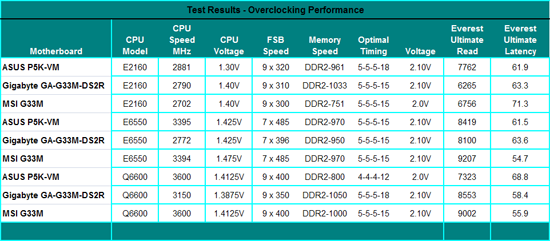µATX Part 2: Intel G33 Performance Review
by Gary Key on September 27, 2007 3:00 AM EST- Posted in
- Motherboards
Overclocking Performance Summary
Over the next three pages we will show the overclocking details, but the general results are listed above if you want to skip ahead. The ASUS P5K-VM is the overall best overclocking G33 board and rivals several P35 boards. The MSI board overclocks very well with 1066MHz or 1333MHz FSB CPUs but has trouble with 800MHz FSB CPUs. Also, the MSI board typically needs additional CPU voltage compared to the ASUS board, but memory speeds are generally higher.
The Gigabyte board overclocks well for a typical uATX board but we had several problems with stability above 400FSB using the F5 BIOS. We had better results with the F4 BIOS in testing. The MSI and Gigabyte boards offer limited memory ratios for the 800MHz FSB CPUs which limit overclocking with them unless you purchase expensive DDR2-1066 memory. This is a real problem with us is the 3.33 or 4.0 ratio when utilizing an 800FSB CPU on the Gigabyte board. This is unacceptable for a board with a performance oriented tilt in the uATX market sector. That being said, we were able to run our OCZ HPC Reaper at significantly higher speeds on the Gigabyte board and actually broke the 1100MHz barrier, but it required 2.2V which is outside the manufacturer's limit. Although the Gigabyte board ran memory at higher overall speeds than the other two boards, it was at the expense of chipset and memory sub-timings in most instances.
| MSI G33M / Gigabyte GA-G33M-DS2R / ASUS P5K-VM Overclocking | |
| Processor | Intel Pentium (Core 2 Based) E2160 Dual Core, 1.8GHz, 1MB Unified Cache, 9x Multiplier, 800FSB |
| CPU Voltage | Variable - 1.2750V ~ 1.4750V |
| Cooling | Scythe Ninja Mini |
| Power Supply | Seasonic S-12 II 430W |
| Memory | OCZ HPC Reaper PC2-6400 (4x1GB) |
| Memory Settings | Variable - DDR2-800 ~ DDR2-1050 |
| Video Cards | Gigabyte HD 2600XT |
| Video Drivers | AMD 7.9 |
| BIOS | MSI 1.10, Gigabyte F5, ASUS 0401 |
| Operating System | Windows Vista Home Premium 32-bit |
| . | |
 |
| Click to enlarge |
Over the next three pages we will show the overclocking details, but the general results are listed above if you want to skip ahead. The ASUS P5K-VM is the overall best overclocking G33 board and rivals several P35 boards. The MSI board overclocks very well with 1066MHz or 1333MHz FSB CPUs but has trouble with 800MHz FSB CPUs. Also, the MSI board typically needs additional CPU voltage compared to the ASUS board, but memory speeds are generally higher.
The Gigabyte board overclocks well for a typical uATX board but we had several problems with stability above 400FSB using the F5 BIOS. We had better results with the F4 BIOS in testing. The MSI and Gigabyte boards offer limited memory ratios for the 800MHz FSB CPUs which limit overclocking with them unless you purchase expensive DDR2-1066 memory. This is a real problem with us is the 3.33 or 4.0 ratio when utilizing an 800FSB CPU on the Gigabyte board. This is unacceptable for a board with a performance oriented tilt in the uATX market sector. That being said, we were able to run our OCZ HPC Reaper at significantly higher speeds on the Gigabyte board and actually broke the 1100MHz barrier, but it required 2.2V which is outside the manufacturer's limit. Although the Gigabyte board ran memory at higher overall speeds than the other two boards, it was at the expense of chipset and memory sub-timings in most instances.










26 Comments
View All Comments
sprockkets - Friday, September 28, 2007 - link
Sad how an AMD 7050 board can be had for $80, $40 cheaper with the same features. It is the premium you pay for having dvi.Oddly enough too is that the Gigabyte board you quote doesn't use all solid caps yet the lower end board does. And of course, they didn't bother with solid caps on their new AMD boards period, cause "AMD is second tier."
tayhimself - Thursday, September 27, 2007 - link
Preposterous!! Why do they even bother making this junk without DVI. More and more I find that I don't want a leet board that overclocks 100 Mhz higher but a stable board with the right features. -sigh-8steve8 - Thursday, September 27, 2007 - link
and on top of it, these igp's are not suited well for gaming or videos,,, (the two applications where you may not notice the difference between a digital and analog interface), so they will be used for text/office work... an application where the discrepancies in the user-experience of analog vs digital interfaces with an LCD are undeniable.again, great article.,, but in the end, I sort of wonder why waste ur time exploring these boards when your time is better spent on solutions that deserve our money?
JarredWalton - Thursday, September 27, 2007 - link
I think both of those G33 + SDVO models launched long after Gary had started work on this uATX stuff. Good to see that some people are including the necessary chip, as uATX without DVI is simply unacceptable. Unfortunately, testing some of this stuff takes a lot more time than we would like. We're working to address that, however.jenli - Thursday, September 27, 2007 - link
I would love to see a review of motherboards with igpthat can be converted to raid servers by using the lone
pcie 16x slot.
Have fun,
CK804 - Thursday, September 27, 2007 - link
I'm doing exactly what you mention with an Intel DG965RY. I have an Areca ARC-1210 fitted in there with 3 320GB WD Caviar SE16s in RAID 5.